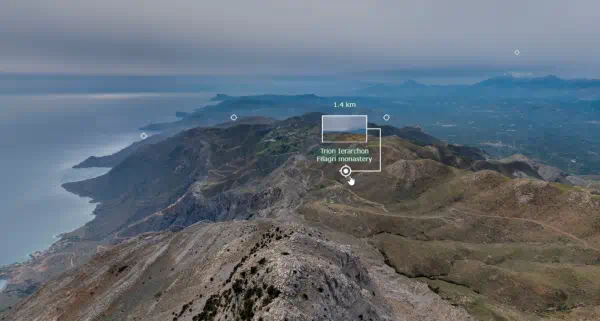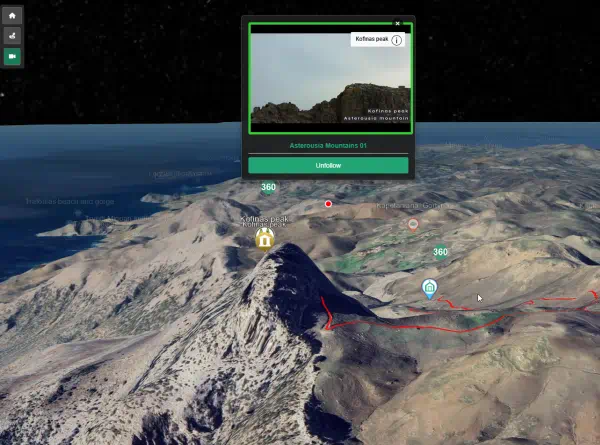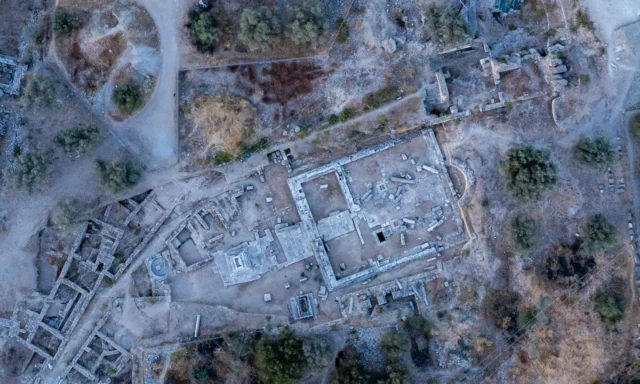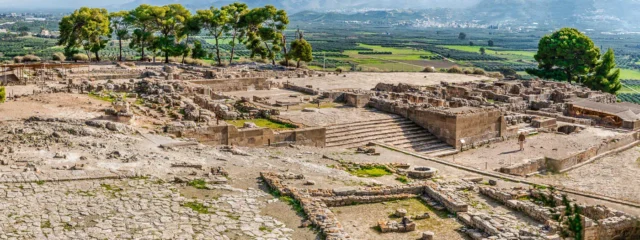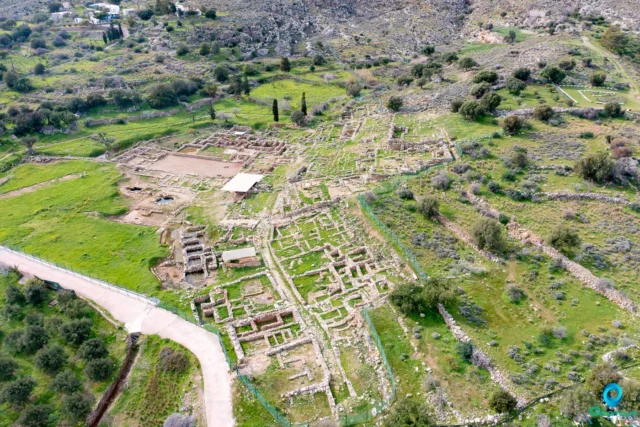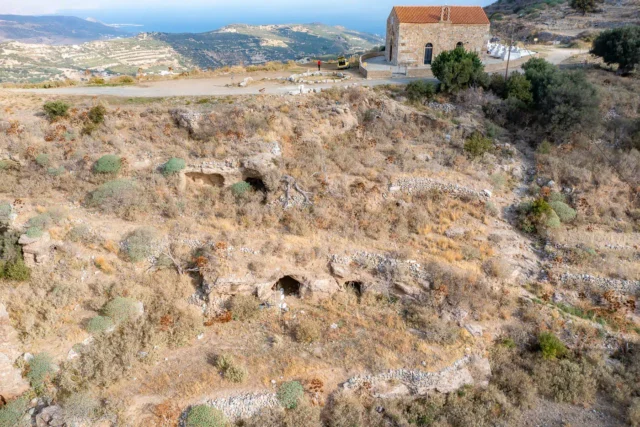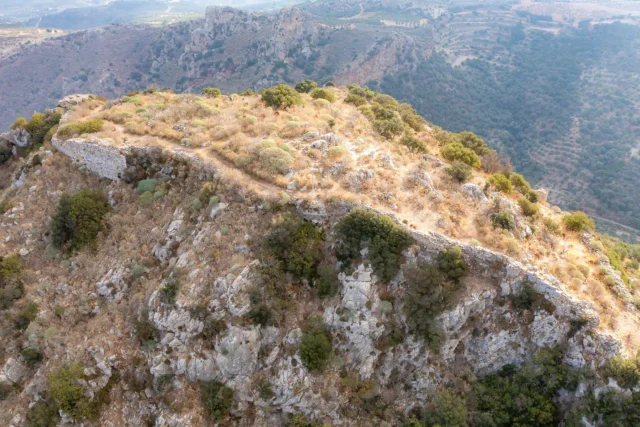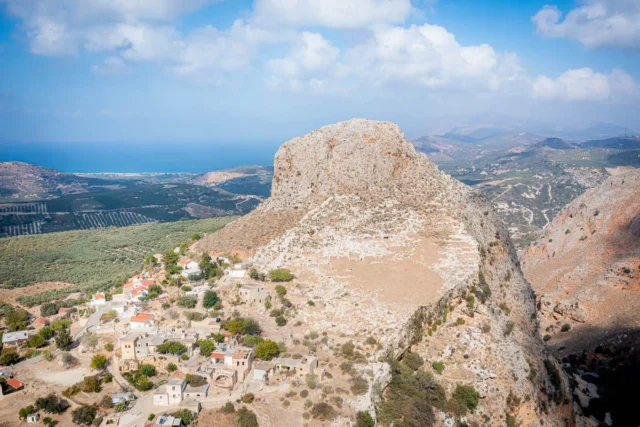Founding and Early History
While the city’s origins were once considered mysterious, recent archaeological work has significantly pushed back its known history. Excavations in 2024 on the city’s acropolis uncovered a Neolithic layer for the first time, dating to approximately 3500 BCE. Finds from this period include handmade pottery, polished stone axes, and tools made of chert, obsidian, and quartz (SADENTREPESE, 2025). Additionally, some Minoan-era ceramics have been found, confirming a continuous prehistoric presence that aligns with Falasarna’s pre-Greek name. This earliest occupation appears to be connected to the use of caves on the acropolis, on the ruins of which the later fortified city was built (SADENTREPESE, 2025). This long history underscores the strategic importance of the entire Kastri (Koutri) peninsula throughout the millennia. Although this early settlement existed, more substantial habitation evidence dates to the Geometric period (9th-8th centuries BCE). The city’s strategic location on the western coast of Crete, near the end of the Korykos Cape, made it an important center for trade and maritime activity.
Classical and Hellenistic Periods
Falasarna rose to prominence during the Classical and Hellenistic periods (5th-2nd centuries BCE). The city’s well-organized harbor and its strategic location made it a key player in the trade networks of the Mediterranean. Falasarna was also involved in piracy and the slave trade, which contributed to its wealth and influence. (TZANAKAKI, 2019)
The city’s history during this period was marked by conflicts with neighboring city-states, particularly Polyrrhenia. Polyrrhenia, located further inland, sought to control Falasarna and its harbor to gain access to the sea and expand its trade routes. The rivalry between the two cities led to a series of wars and alliances, with Falasarna often siding with Knossos, another powerful city-state on the island. (MLINAR, 2011)
Roman Conquest
In the 2nd century BCE, the Romans extended their influence over the eastern Mediterranean, eventually reaching Crete. In 67 BCE, the Roman consul Quintus Caecilius Metellus led a campaign to conquer the island, and Falasarna, despite its fortifications and resistance, was captured by Metellus’ forces. The Roman conquest marked the end of Falasarna’s independence and its integration into the Roman province of Crete and Cyrenaica.
Archaeological Significance
Excavations and Discoveries
The archaeological site of Falasarna has been the subject of extensive excavations and research, revealing a wealth of information about the city’s history, culture, and daily life. The excavations have unearthed various structures, including houses, temples, and public buildings, providing insights into the city’s urban planning and architecture. (VASILAKIS, n.d.)
The Temple of Demeter
Recent excavations have focused on a significant sanctuary dedicated to the goddess Demeter, discovered in 2022 on the acropolis. Worship at the site dates to the early 7th century BCE, originally taking place in a natural cave fed by a spring. After the cave collapsed, a formal temple was founded upon its ruins in the 5th century BCE. The dried-up water collectors were later used for ritual deposits (SADENTREPESE, 2025).
These deposits have yielded numerous votive offerings from the Archaic and Classical periods, including clay heads of Demeter wearing a polos (a high crown), figurines of robed women (peplophoroi), miniature decorated hydriae, and silver and bronze jewelry. The goddess’s name was found inscribed in the Doric dialect on dozens of these offerings. Of particular interest are numerous 7th-century BCE figurines in the orientalizing Daedalic style, which are among the oldest of their kind found in Crete. Scholars are exploring a possible link between these figures and the Phoenician mother-goddess Astarte, a theory supported by other Phoenician artifacts found at Falasarna. Further excavations in 2023 and 2024 revealed pits containing offerings such as intact figurines of birds, turtles, and pigs, suggesting that the Thesmophoria, a festival in honor of Demeter and her daughter Persephone, was celebrated here (SADENTREPESE, 2025).
Harbor Fortifications
Ongoing work has also concentrated on the city’s impressive harbor fortifications. The grand fortification gate, constructed with massive, well-dressed ashlar blocks and an elegant band decoration, dates in its current form to the 2nd century BCE, though it was built upon an earlier structure from the 5th century BCE or even before. The discovery of numerous Corinthian-type roof tiles indicates the gate was once a roofed structure (SADENTREPESE, 2025).
One of the five defensive towers of the harbor, Tower 2, was fully excavated in 2023. Rows of its massive stones were found fallen in sequence, providing clear evidence of the tower’s destruction during the major earthquake of 365 CE. The foundations of all five towers are at the same level, confirming that the harbor complex was constructed as a single project in the 4th century BCE, with uniform architectural standards, a fact corroborated by the contemporary geographer Scylax (SADENTREPESE, 2025).
Necropolis
The necropolis of Falasarna, located to the south-east of the city, has also been excavated, revealing various types of tombs, including chamber tombs and tholos tombs. The tombs have yielded a variety of artifacts, such as pottery, jewelry, and weapons, providing insights into the burial customs and beliefs of the ancient Falasarnaians.
Historical Significance
The archaeological discoveries at Falasarna have contributed significantly to our understanding of the history and culture of ancient Crete, particularly during the Classical and Hellenistic periods. The city’s involvement in trade, piracy, and the slave trade, as well as its conflicts with neighboring city-states, offer a glimpse into the complex political and economic landscape of ancient Greece. (TZANAKAKI, 2019)
Current Status
Preservation and Restoration
Today, the archaeological site of Falasarna is a protected area. Ongoing excavations, such as the planned work in August 2025, are coupled with efforts to preserve and restore the remaining structures (SADENTREPESE, 2025). The main goals include the rescue and study of artifacts from the Temple of Demeter and the restoration of its architectural remains. The city walls, towers, and gates have been partially restored, allowing visitors to appreciate the city’s impressive defense system. (VASILAKIS, n.d.)
Museum
A small museum has been established at the site, showcasing some of the artifacts discovered during the excavations. The museum provides visitors with a deeper understanding of the city’s history and culture, complementing their experience of exploring the archaeological site.
Tourism
The archaeological site of Falasarna is a popular tourist destination, attracting visitors from around the world. The site offers a unique opportunity to step back in time and experience the remains of an ancient Greek city, with its impressive fortifications, its well-organized harbor, and its rich history.
Site: Key Points
- Construction Period: Late Neolithic (c. 3500 BCE), Geometric period (9th-8th centuries BCE)
- Location: Western coast of Crete, near the end of Korykos Cape
- Dimensions: The city walls extended for approximately 2.5 km, enclosing an area of about 100 hectares.
- Historical Significance: A prominent city-state in ancient Greece, known for its strategic location, its well-organized harbor, and its involvement in trade, piracy, and the slave trade.
- Current Status: A protected archaeological site, partially restored and open to the public.
References
- MLINAR, E. (2011). Fortified towns, settlements and other strongholds on Crete from Archaic through Hellenistic times. In ΠΕΠΡΑΓΜΕΝΑ Ι ΔΙΕΘΝΟΥΣ ΚΡΗΤΟΛΟΓΙΚΟΥ ΣΥΝΕΔΡΙΟΥ (ΧΑΝΙΑ, 1-8 ΟΚΤΩΒΡΙΟΥ 2006) (pp. 23-32). ΦΙΛΟΛΟΓΙΚΟΣ ΣΥΛΛΟΓΟΣ Ο ΧΡΥΣΟΣΤΟΜΟΣ.
- SADENTREPESE. (2025). ΑΡΧΑΙΟΣ ΠΟΛΕΜΙΚΟΣ ΛΙΜΕΝΑΣ ΦΑΛΑΣΑΡΝΑΣ / ΔΕΛΤΙΟ ΤΥΠΟΥ. Retrieved from https://sadentrepese.blogspot.com/2025/07/blog-post_65.html?m=1
- TZANAKAKI, K. (2019). Ancient cities of westernmost Crete (Prefecture of Chania): Kydonia, Aptera, Polyrrhenia, Phalassarna, Hyrtakina and Elyros. In CRETAN CITIES. THE TESTIMONY OF COINS (pp. 35-43). ALPHA BANK, UNIVERSITY OF CRETE, EPHORATE OF ANTIQUITIES OF RETHYMNO, MUSEUM OF ANCIENT ELEUTHERNA.
- VASILAKIS, A. T. THE 147 CITIES OF ANCIENT CRETE.
- ZERVOUDAKIS, P. (2024). Kourotrophic deities in Archaic Crete: schwarzfigurige Darstellung der Geburt der Artemis, gefunden im Tempel der Demeter, Phalasarna. Paper presented at the 25th Annual Meeting of the European Association of Archaeologists, Rome.

